#herbal garden
Text

Garden Upgrade Available. Please begin.
+ 25 Garden XP ; Herbs Available
-> Welcome to the vertical oasis tutorial, where you'll learn to turn a small space into an herbal fortune.
Ready to Start?
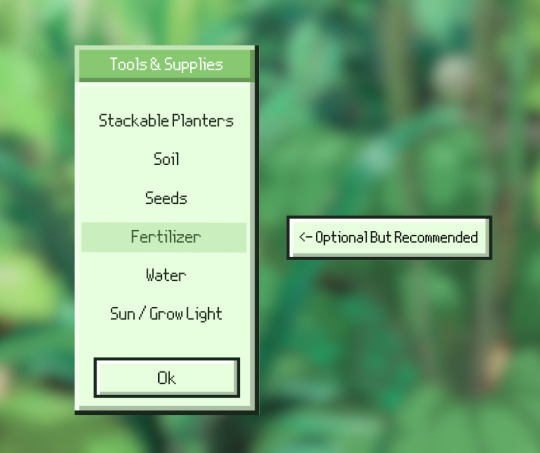
You'll need a few things to get started and a little bit of time. To start, you'll need some sort of space to work with. For my personal herb tower I'm using stackable planters that are around 1.2 sq ft (14 inches i think) + 5 in deep.
[ These from dollar tree specifically ]
I recommend a place that has at least partial sunlight available. If you live in an area with no outside space, you can place this near a window + add a grow light if you need. I also use fish fertilizer which is completely optional but recommended, as it can help grow strong, fruitful plants. The amount of plants you have will primarily depend on your vertical space available.
I have ~ 6ft worth of vertical space (which I'll need a step stool to tend to) and I plan on using it. My planters are about 5 inches tall, which means I can fit a maximum of fourteen of these planters. But I'll only be doing twelve so that the plants have a little bit of room at the top of the stack. That means, in total, I will have 36 "pots" for plants. The downside is, the plants will grow outwards and up, which means I can't have big plants.

Choosing seeds can be a little frustrating when you're new to this. For simplicity sake, we'll say you have around the same amount of space that I have. Since this is an herbal oasis, we'll focus on that.
One thing I absolutely recommend is marigold (edible variety means brownie points) because it's a wonderful pest repellent. It also helps the bees out, so! Marigold is good.
You can use the list provided in the image or you can come up with your own list of things to plant. Personally, each "tier" will get three of the same plants. Otherwise I forget what I planted where. If you have a lot of vertical planters, get a plant caddy so it's easy to rotate and move.

I do recommend you spend a little time learning which plants need the most sun / water but otherwise gardening is fairly straight forward. If something is wrong with your plant, you will know. The leaves will change or wilt, the plant will stop growing, etc. And remember, you can always try again.

#filed under: resources#filed under: projects#gardening#tutorial#bunny gardens#herbal oasis#herbal garden#herbs#plants#plantblr#aesthetic#plantcore#+ 25 garden xp#garden upgrade#garden#greenery#tea#how to#life hacks#helpful#made by bunny#open folder: fun
31 notes
·
View notes
Photo
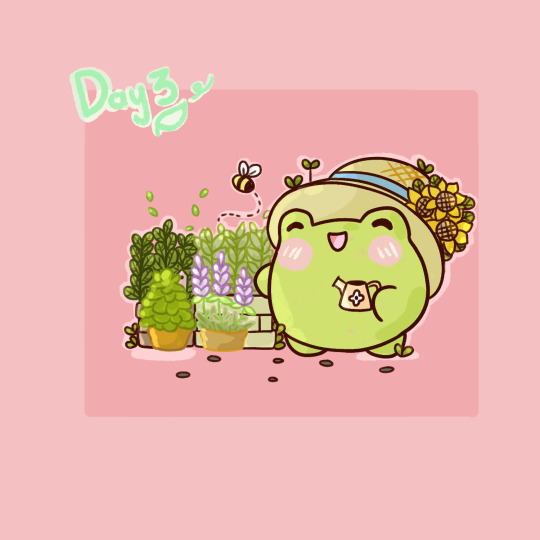
Day 3 of FroggyFall herbal garden !!!
16 notes
·
View notes
Text
Exploring the Uses of Medicinal Plants: Nature's Pharmacy

Introduction to Medicinal Plants
Medicinal plants have been integral to human health and wellness for millennia, offering a treasure trove of natural remedies that continue to play a crucial role in both traditional and modern medicine. In this comprehensive exploration, we delve into the diverse uses of medicinal plants, from their historical significance to their potential future in research and innovation.
Definition and Historical Significance
Medicinal plants encompass a broad spectrum of botanical species that have been utilized for their therapeutic properties. This practice dates back to ancient civilizations, where healers and shamans discovered the healing potential of various plants, laying the foundation for herbal medicine.
Importance in Traditional and Modern Medicine
Throughout history, medicinal plants have been the cornerstone of traditional healing systems across cultures, from Ayurveda in India to Traditional Chinese Medicine (TCM) and Native American herbalism. In modern times, these plants remain vital, providing sources of active compounds for pharmaceutical drugs and serving as natural alternatives for health and wellness.
Common Medicinal Plants
Overview of Well-Known Plants (e.g., Aloe Vera, Ginseng, Turmeric)
Certain medicinal plants have gained widespread recognition for their health benefits. Aloe vera, known for its soothing properties, is used to treat burns and skin irritations. Ginseng is prized in traditional Asian medicine for its apoptogenic properties, promoting vitality and longevity. Turmeric, has potential anti-inflammatory and antioxidant effects due to its active compound curcumin.
Their Traditional and Current Uses
These plants have versatile applications. Aloe vera is used in skincare products, herbal remedies, and even beverages for its cooling and healing properties. Ginseng is incorporated into tonics and supplements to boost energy and enhance cognitive function. Turmeric finds its way into culinary dishes and dietary supplements, offering support for joint health and overall wellness.
Health Benefits of Medicinal Plants
Overview of Various Health Conditions Treated
Medicinal plants address a wide range of health conditions, spanning digestive issues, skin disorders, immune support, respiratory ailments, and more. Each plant contains unique bioactive compounds that target specific areas of health.
Examples: Digestive Issues, Skin Disorders, Immune Support
For digestive health, plants like peppermint and ginger aid in soothing upset stomachs and relieving nausea. Calendula and lavender are prized for their skin-healing properties, used in ointments and creams for eczema and wounds. Immune-boosting plants such as echinacea and elderberry are popular during cold and flu seasons.
You may try this kit for your better health through herbs.
Phytochemicals and Active Compounds
Explanation of Phytochemicals
Phytochemicals are bioactive compounds found in plants that contribute to their medicinal properties. These include polyphenols, flavonoids, alkaloids, and terpenes, each with specific health-promoting effects.
Importance of Active Compounds in Medicinal Plants
The efficacy of medicinal plants hinges on their active compounds. For instance, the polyphenols in green tea exhibit antioxidant properties, protecting cells from oxidative stress. Alkaloids like caffeine in coffee and tea contribute to their stimulating effects on the nervous system.
Antioxidant Properties
Role of Medicinal Plants in Fighting Oxidative Stress
Oxidative stress contributes to aging and disease by causing cellular damage. Medicinal plants rich in antioxidants, such as blueberries and green tea, help neutralize free radicals and reduce oxidative damage.
Examples of Plants with High Antioxidant Content
Berries like goji and acai are celebrated for their antioxidant-rich profiles, offering protection against chronic diseases like heart disease and cancer. Turmeric, with its potent curcuminoids, also exhibits strong antioxidant effects.
Anti-inflammatory Effects
How Medicinal Plants Reduce Inflammation
Inflammation underlies many chronic diseases, from arthritis to cardiovascular conditions. Medicinal plants like ginger, turmeric, and willow bark contain compounds that inhibit inflammatory pathways, offering natural relief without the side effects of conventional anti-inflammatory drugs.
Plant Examples (e.g., Ginger, Turmeric, Willow Bark)
Gingerols in ginger and curcumin in turmeric are known for their anti-inflammatory properties, making them popular choices for joint pain and muscle soreness. Willow bark contains salicin, a precursor to aspirin, which eases pain and reduces inflammation.
This kit may help you to maintain your health better through herbs.
Digestive Health
Medicinal Plants for Digestive Disorders
Plants like peppermint, chamomile, and fennel seeds are used to alleviate digestive discomfort, including bloating, indigestion, and irritable bowel syndrome (IBS). These herbs promote healthy digestion and soothe gastrointestinal distress.
Natural Remedies for Common GI Issues
Peppermint oil relaxes intestinal muscles, easing spasms and discomfort. Chamomile tea reduces inflammation in the gut lining, while fennel seeds aid in digestion and reduce gas.
Immune System Support
Plants That Boost Immunity
Echinacea, garlic, and astragalus are renowned for their immune-enhancing properties. These plants stimulate the immune response and help the body fend off infections.
Apoptogenic Plants and Their Role
Apoptogenic herbs like ashwagandha and holy basil help the body adapt to stress, which indirectly supports immune function by reducing the negative impact of stress hormones on immunity.
Skin Care and Healing
Use of Plants in Skincare Products
The beauty industry incorporates medicinal plants into skincare formulations for their nourishing and healing effects. Aloe vera gel, shea butter, and rosehip oil are popular ingredients in natural skincare products.
Healing Properties of Medicinal Plants for Skin Conditions
Calendula soothes inflamed skin and promotes wound healing. Tea tree oil is used for its antibacterial properties in treating acne. Rosemary extract acts as a natural preservative and antioxidant in cosmetic products.
Pain Relief
Natural Pain-Relieving Properties of Plants
Plants like cannabis, willow bark, and capsaicin (from chili peppers) are effective pain relievers. They work through various mechanisms to alleviate pain without the adverse effects of opioids.
Comparison with Pharmaceutical Options
Medicinal plants offer a gentler alternative to pharmaceutical painkillers, with fewer side effects and a lower chance of addiction. For chronic pain management, herbal remedies provide sustainable relief.
Stress and Anxiety Management
Plants for Calming Effects
Lavender, passionflower, and valerian root are used to reduce stress and anxiety. These plants have sedative properties that promote relaxation and improve sleep quality.
Role of Herbal Teas and Aromatherapy
Herbal teas infused with chamomile or lemon balm have calming effects on the nervous system. Essential oils like lavender and bergamot used in aromatherapy alleviate stress and uplift mood.
Cardiovascular Health
Plants for Heart Health
Hawthorn, garlic, and flaxseed are beneficial for cardiovascular health. They support healthy blood pressure, cholesterol levels, and overall heart function.
Impact on Blood Pressure and Cholesterol Levels
Garlic contains allicin, which helps lower blood pressure and cholesterol. Hawthorn berries improve blood flow to the heart and strengthen its contractions.
Respiratory Health
Medicinal Plants for Respiratory Issues
Eucalyptus, peppermint, and thyme are valued for their respiratory benefits. They relieve congestion, soothe coughs, and support lung health.
Examples: Eucalyptus, Peppermint, Thyme
Eucalyptol in eucalyptus oil acts as a natural decongestant, while menthol in peppermint oil opens airways and relieves sinus pressure. Thyme contains thymol, an expectorant that loosens phlegm.
Cancer Prevention and Support
Role of Medicinal Plants in Cancer Prevention
Certain plants like turmeric, green tea, and berries possess anti-cancer properties. They inhibit tumor growth and protect cells from oxidative damage.
Complementary Use with Conventional Treatments
Medicinal plants complement conventional cancer treatments, helping to manage side effects like nausea and fatigue. They may also enhance treatment efficacy and improve overall quality of life.
Women’s Health
Plants for Menstrual Issues and Menopause Symptoms
Black cohosh, dong quai, and chaste berry are used to alleviate menstrual cramps and menopausal symptoms. These herbs regulate hormonal balance and support reproductive health.
This guide may also help you to keep yourself fit through nature.
Safety and Efficacy Considerations
While herbal remedies can be effective, it's essential to consult with a healthcare provider, especially during pregnancy or when managing chronic conditions. Proper dosage and quality control are crucial for safety.
Memory and Cognitive Function
Plants That Enhance Brain Health
Ginkgo biloba, bacopa, and gotu kola are known for their cognitive-enhancing effects. They improve memory, concentration, and overall brain function.
Impact on Memory and Concentration
Ginkgo biloba increases blood flow to the brain, enhancing cognitive performance. Bacopa monnieri supports neurotransmitter function, improving memory retention and mental clarity.
Metabolic Health
Plants That Support Metabolism
Cinnamon, bitter melon, and fenugreek aid in metabolic health. They regulate blood sugar levels, promote insulin sensitivity, and support weight management.
Effects on Weight Management
Green tea catechins and capsaicin from chili peppers boost metabolism and promote fat burning. These plants are valuable additions to a healthy diet and exercise routine.
Sustainability and Ethical Harvesting
Importance of Responsible Sourcing
As demand for medicinal plants grows, sustainable harvesting practices are vital to preserve biodiversity and protect natural habitats. Ethical sourcing ensures the long-term viability of medicinal plant resources.
Promoting Biodiversity and Conservation
Cultivation of medicinal plants through organic farming and wildcrafting supports ecosystem health and maintains genetic diversity. Conservation efforts safeguard endangered species and promote sustainable use.
Cultural and Ritual Uses
Traditional Practices Involving Medicinal Plants
Medicinal plants hold cultural significance in rituals and ceremonies worldwide. Indigenous cultures have preserved ancient healing traditions centered around plant-based medicine.
Significance in Various Cultures
For example, Ayahuasca, a psychoactive plant brew, is used by Amazonian tribes for spiritual healing and enlightenment. Native American tribes employ sage and cedar for purification rituals.
Future of Medicinal Plant Research
Trends in Herbal Medicine
Advancements in technology and scientific research are uncovering new applications for medicinal plants. Phytopharmaceuticals and herbal supplements continue to gain popularity in mainstream healthcare.
Potential Discoveries and Innovations
Research on plant genomics, bioavailability of phytochemicals, and synergistic effects of herbal combinations offer promising avenues for novel therapies. The future holds exciting prospects for harnessing the full potential of medicinal plants.
Conclusion
The multifaceted uses of medicinal plants span ancient traditions to cutting-edge research, demonstrating their enduring relevance in promoting health and well-being. As we navigate an era of holistic healthcare, incorporating these natural remedies into our lifestyles fosters a harmonious relationship with nature and unlocks the profound healing potential of botanical medicine.
Here you may try this kit for your health care through herbs.
Wish you the best of your health!
DISCLAIMER:
Some of the links in this article are affiliate links, which means I may earn a commission if you purchase through those links.
#health tips#Nature's Pharmacy#uses of medicinal plants#myherbal#herbal garden#Chicory Coffee#Quick Backyard Remedy#Medicinal Garden#Herbal Medicine#herbalism#health and wellness
1 note
·
View note
Text

🌿 Introducing The Medicinal Garden Kit: Your Path to Health Empowerment!
Are you ready to reclaim control of your well-being? The creators of The Lost Ways and The Lost Book of Remedies proudly present a revolutionary solution: The Medicinal Garden Kit. Crafted for health enthusiasts, herbalists, and those embracing self-sufficiency, this kit is your gateway to a holistic, nature-driven approach to wellness.
🌱 Why The Medicinal Garden Kit?
Imagine having a treasure trove of nature's healing powers at your fingertips. Our kit isn't just about gardening; it's a lifestyle shift towards self-reliance and wellness.
🌿 What's Inside?
• Comprehensive Guidebook: Dive deep into the world of herbal remedies, gardening tips, and self-sufficiency hacks. • Handpicked Seeds Collection: Grow a bountiful array of medicinal plants right at home. • Expertly Curated Tools: Equip yourself with the essential tools for nurturing your own medicinal garden. • Exclusive Access: Gain access to a community of like-minded individuals on a similar journey to self-empowerment.
🌱 Join the Movement!
The time to reclaim your health sovereignty is now. No more reliance on synthetic remedies or external solutions. The power lies within your hands, quite literally.
🌿 Who Is It For?
Perfect for health aficionados, herbal enthusiasts, DIY enthusiasts, survivalists, and anyone seeking a natural, self-sufficient lifestyle. Whether you're a seasoned gardener or a novice, this kit is your key to unlocking the secrets of nature's pharmacy.
🌱 Your Journey Starts Now!
Don't miss this opportunity to cultivate your very own medicinal haven. Order your Medicinal Garden Kit today and embark on a transformative journey toward health, self-sufficiency, and empowerment.
Empower your health. Nurture your well-being. Order your Medicinal Garden Kit now! https://www.digistore24.com/redir/379812/ness0528/ph
#herbalwellness#herbal garden#healthempowerment#medicinal herbs#medicinal plants#medicinal garden kit#garden tips
0 notes
Text
Nature Is My Medicine, Herbal Medicine, Herbs, Herbalism, Vintage, Distressed T-Shirt

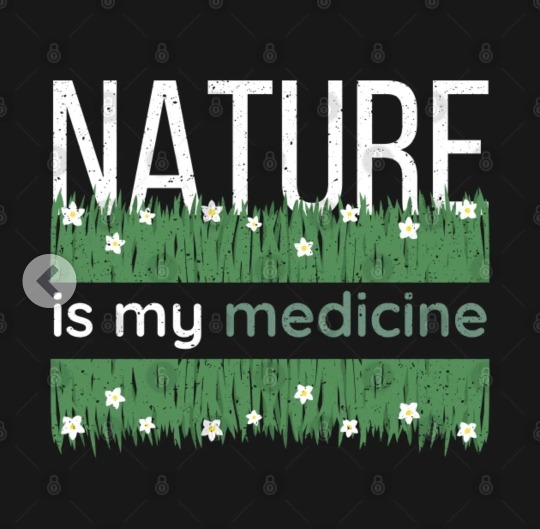
https://www.teepublic.com/t-shirt/53751311-nature-is-my-medicine-herbal-medicine-herbs-herbal?store_id=2653754
#helengie#teepublic#classic tshirt#permaculture#gardening#house plant#plants make people happy#plants and herbs#potted plants#herbal garden#herbal healing#herbal#ayurveda#natural healing#naturopatia#naturopathy#retro vintage#vintage tshirt#black clothing#retro clothes#vintage clothing#clothes#online shoppping#shopping#gardener#christmas gift ideas#christmas presents#christmas gift#gift ideas#gift
1 note
·
View note
Photo
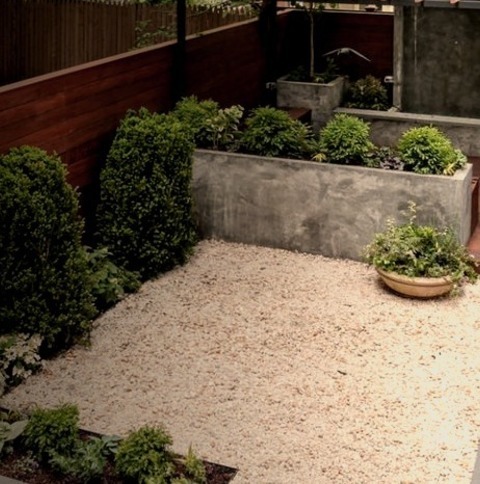
Deck Covered New York
Mid-sized contemporary ground-level water fountain deck with a pergola featuring mixed-material railings
0 notes
Link
#top4 herbs to be grown at home#herbs to grow easily#herbs to grow#tulsi#basil#omavalli#mexican mint#herbs must grow#must grow herbs#herbs#herbal#herbal garden#herbal remedyy#kitchen garden#micro greens#greens#green vegetables#garden#good love#good vibes#good life#health#healthy#healthy life#healthy food#famille#momsqna
0 notes
Text




The house from Practical Magic (1998)
#cottagecore#antiques#victorian#vintage#greenhouse#garden#florals#witch craft#witchy#witches#herbalism#cottage moodboard#cottage#practical magic
3K notes
·
View notes
Text
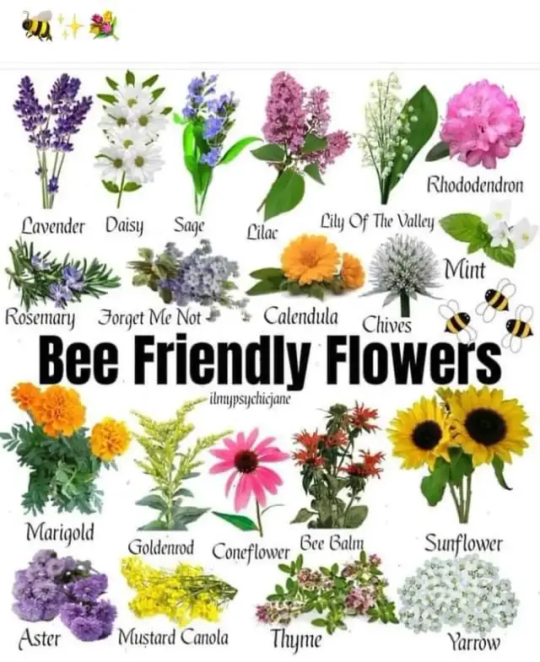
#khajiit metaphysical#stolen from facebook#witchblr#witchcraft#witch#cottagecore#witchcore#garden#bees#save the bees#floral witch#flowers#herbal witch#herbs#cottage witch#green witch#ecletic witch#water witch#forest witch#plantblr#plants#flowerblr#beeblr
455 notes
·
View notes
Text

#cozycore#cottage life#cottagecharm#cottagestyle#grandma aesthetic#plants#warmcore#countrycore#cottage garden#gardencore#herbalmedicine#herbology#herbalism#herbal magick#plants and herbs#plant core#plant aesthetic#plantblr#mushroom aesthetic#mushroomcore#mushrooms#spell jars#spell jar#kitchen witch#witches#witchcraft#cottage witch#earth witch#kitchen witchcraft#green witchcraft
748 notes
·
View notes
Text
hey do me a favor and reblog this
530 notes
·
View notes
Text
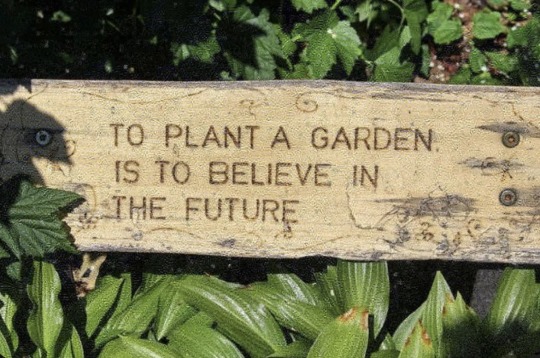
via pinterest
585 notes
·
View notes
Text
723 notes
·
View notes
Text

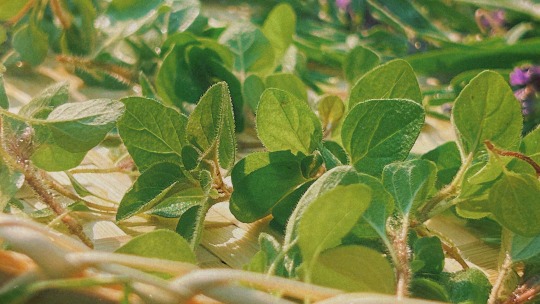


Drying some marigold, lavender (mostly leaves), and oregano to mix in with the goldenrod I harvested last week for tea. Also, how is it September already? The fuck!?
1-Sep-2023
#tea#herbal tea#herbalism#marigold#lavender#oregano#gardencore#cottagecore#cottage charm#homestead#gardening#harvest#canning and preserving#garden#plant community#plantblr#garden 2023#plants
211 notes
·
View notes
Note
yo, puffballs can be used to dress wounds? how does that work?
It's the simplest use in the world. I wouldn't even be able to make a whole guide on puffballs as a wound-dressing it's so simple. You literally just cut and apply to a bleeding wound.
It's a hemostatic; its spores stop the bleeding. So when it comes to puffballs, you either harvest them young and eat them, or let them mature and harvest as a medicine.

This is a puffball when it's young enough to be edible. The flesh is pure white. When the spores have started to form, this will turn yellowish and become a poison if ingested.
You can just use a slice as a gauze, or powder it. It's that simple. No processing required. It makes the blood coagulate and stops bleeding.
#Culpepper was a good guide for the writers to use to be fair#For the very basics#But once you actually start to move past the basics you realize that a lot of the treatments they use in canon would actually be-#-totally inaccessible#Because culpepper assumes you have a garden.#And he ends up totally skipping over some SUPER useful and relevant historic herbal treatments#Such as puffballs#But to be farierer I do have like... a bit of a background in pharmacognacy because of a family member being educated in this#so I kinda know what to look for and How things work#But anyway yeah#Herb Guide#Clan Culture#Puffballs#Mushrooms
173 notes
·
View notes
Text
Nature Is My Medicine, Herbal Medicine, Herbs, Herbalism, Vintage, Distressed T-Shirt
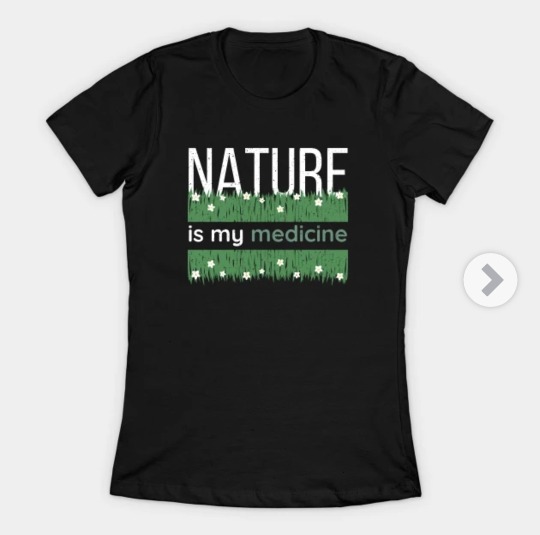
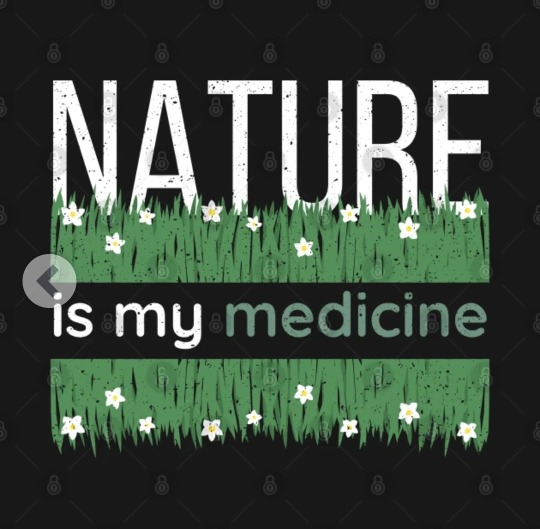
https://www.teepublic.com/t-shirt/53751311-nature-is-my-medicine-herbal-medicine-herbs-herbal?store_id=2653754
#Nature Is My medicine#nature heals#ayurveda#natural healing#naturopathy#naturopatia#teepublic#force of nature#helengie#classic tshirt#medicinal herbs#plants and herbs#herbs#herbal#herbal garden#herbal healing#herbal medicine#herbal plants#alternative medicine#balance#meadow#love nature#mother nature#nature#nature enthusiast#nature is everything#vintage tshirt#potted plants#house plant#plants
0 notes